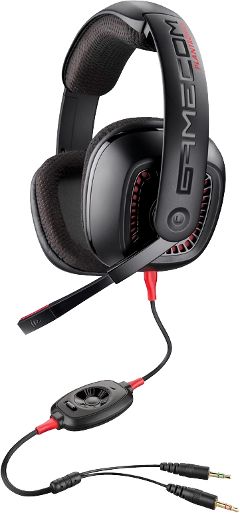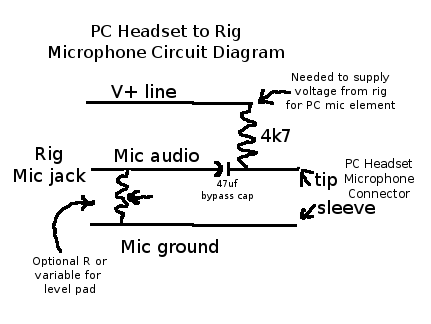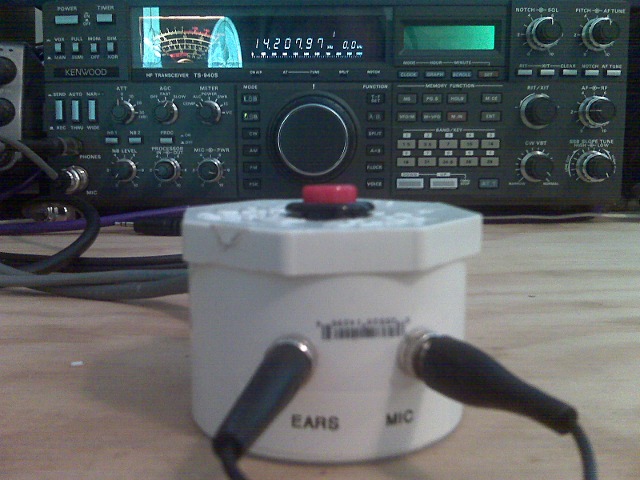PC Headset Adapter for Ham Radio
So I wanted a headset/boomset for use with my ham radio equipment. I knew I wouldn't use it all that frequently so the high prices for the Heil products didn't make a lot of sense to me.
A bunch of guys have posted pages about using PC headsets and microphones, cell phone headsets and other similar mics with ham equipment, so I decided to give it a try myself.
 This is the headset I chose. The Plantronics GameComm 377. It has nice large speaker elements and is semi-closed back so that it has decent isolation but still permits having a conversation when the XYL walks up.
The cord that comes with PC headsets has two jacks, both are 3.5mm TRS. One is a stereo headphone jack and the other is the microphone.
This particular model has an in line rotary volume control in the wire as well as a microphone mute switch (very handy for VOX use).
The *magic* here is that the microphone element in these PC mics is an electret and requires a bias voltage to be applied to energize the element. You can't just plug this straight into your radio. So a basic little circuit is needed for the mic connection to handle this properly.
This is the headset I chose. The Plantronics GameComm 377. It has nice large speaker elements and is semi-closed back so that it has decent isolation but still permits having a conversation when the XYL walks up.
The cord that comes with PC headsets has two jacks, both are 3.5mm TRS. One is a stereo headphone jack and the other is the microphone.
This particular model has an in line rotary volume control in the wire as well as a microphone mute switch (very handy for VOX use).
The *magic* here is that the microphone element in these PC mics is an electret and requires a bias voltage to be applied to energize the element. You can't just plug this straight into your radio. So a basic little circuit is needed for the mic connection to handle this properly.
 Here's the circuit diagram you need for the mic connection itself. The value of the 4k7 is to bring voltage over and isn't particularly critical.
A 3.3k would be fine, something in that range to give a bit of protection for when you pull the plug and the contacts briefly short.
I put the wiring into a PVC Schedule 40 pipe cap and plugged the bottom of the pipe cap with a test plug for schedule 80. The dimension of the top of the pipe cap is about 2.5" across. If you click the diagram you can see it in a higher resolution to make reading it a bit easier.
So for Kenwood wiring for a TS-2000 or TS-940 etc, you would run Pin 1 to the mic audio, pin 7 to mic ground and pin 5 is the V+ line.
The rest of the connections not shown are pin 2 for PTT and pin 8, run those two wires into the enclosure and connect them to a momentary SPST switch. This will be your PTT. The red button on the PVC cap is my PTT switch.
As far as the level pad, at least with this headset, I didn't even bother with it. The output level is just fine for the rigs I'm using it with. I would advise testing your results before you add any pad.
For the headphone audio, simply run the headphone line from the rig directly to the 3.5mm stereo jack for the headphones on your enclosure.
I put both of the connections on an enclosure so I could swap in and out any PC mic product I wanted to. This adapter will allow me to use a plain PC desk mic as well without the headphones.
Here's the finished product. The line for the mic plug and headphones runs out the back of it and is plugged into the TS-940 in the background.
Here's the circuit diagram you need for the mic connection itself. The value of the 4k7 is to bring voltage over and isn't particularly critical.
A 3.3k would be fine, something in that range to give a bit of protection for when you pull the plug and the contacts briefly short.
I put the wiring into a PVC Schedule 40 pipe cap and plugged the bottom of the pipe cap with a test plug for schedule 80. The dimension of the top of the pipe cap is about 2.5" across. If you click the diagram you can see it in a higher resolution to make reading it a bit easier.
So for Kenwood wiring for a TS-2000 or TS-940 etc, you would run Pin 1 to the mic audio, pin 7 to mic ground and pin 5 is the V+ line.
The rest of the connections not shown are pin 2 for PTT and pin 8, run those two wires into the enclosure and connect them to a momentary SPST switch. This will be your PTT. The red button on the PVC cap is my PTT switch.
As far as the level pad, at least with this headset, I didn't even bother with it. The output level is just fine for the rigs I'm using it with. I would advise testing your results before you add any pad.
For the headphone audio, simply run the headphone line from the rig directly to the 3.5mm stereo jack for the headphones on your enclosure.
I put both of the connections on an enclosure so I could swap in and out any PC mic product I wanted to. This adapter will allow me to use a plain PC desk mic as well without the headphones.
Here's the finished product. The line for the mic plug and headphones runs out the back of it and is plugged into the TS-940 in the background.
 I forgot to comment on the audio quality of the setup. It's been a very pleasant surprise. I generally run a full ESSB configuration with a studio condenser mic and a Symetrix 528e voice channel for processing. Straight into either my TS-940 or the TS-2000 I've been getting outstanding audio reports and the record and playback over the air has been really pleasing. Exceeded all my expectations for sure.
The response is well balanced and very natural. With a 3kHz TX passband it sounds well beyond stock audio and even on the 940 it sounds like I'm using a much more enhanced configuration.
Narrowing up the TX passband easily knocks out the bottom end response and emphasizes the mid-range. With some processing built into either rig, it easily generates effective noisy conditions audio.
The receive audio quality is fantastic. The speaker elements give nice full wide-range sound so anything from communications grade through ESSB sounds at their best. No annoying emphasis in these phones at the 3kHz+ range so band noise and static isn't aggravated. Very pleasant audio for extended listening use.
Parts List for the project.
I forgot to comment on the audio quality of the setup. It's been a very pleasant surprise. I generally run a full ESSB configuration with a studio condenser mic and a Symetrix 528e voice channel for processing. Straight into either my TS-940 or the TS-2000 I've been getting outstanding audio reports and the record and playback over the air has been really pleasing. Exceeded all my expectations for sure.
The response is well balanced and very natural. With a 3kHz TX passband it sounds well beyond stock audio and even on the 940 it sounds like I'm using a much more enhanced configuration.
Narrowing up the TX passband easily knocks out the bottom end response and emphasizes the mid-range. With some processing built into either rig, it easily generates effective noisy conditions audio.
The receive audio quality is fantastic. The speaker elements give nice full wide-range sound so anything from communications grade through ESSB sounds at their best. No annoying emphasis in these phones at the 3kHz+ range so band noise and static isn't aggravated. Very pleasant audio for extended listening use.
Parts List for the project.
 This is the headset I chose. The Plantronics GameComm 377. It has nice large speaker elements and is semi-closed back so that it has decent isolation but still permits having a conversation when the XYL walks up.
The cord that comes with PC headsets has two jacks, both are 3.5mm TRS. One is a stereo headphone jack and the other is the microphone.
This particular model has an in line rotary volume control in the wire as well as a microphone mute switch (very handy for VOX use).
The *magic* here is that the microphone element in these PC mics is an electret and requires a bias voltage to be applied to energize the element. You can't just plug this straight into your radio. So a basic little circuit is needed for the mic connection to handle this properly.
This is the headset I chose. The Plantronics GameComm 377. It has nice large speaker elements and is semi-closed back so that it has decent isolation but still permits having a conversation when the XYL walks up.
The cord that comes with PC headsets has two jacks, both are 3.5mm TRS. One is a stereo headphone jack and the other is the microphone.
This particular model has an in line rotary volume control in the wire as well as a microphone mute switch (very handy for VOX use).
The *magic* here is that the microphone element in these PC mics is an electret and requires a bias voltage to be applied to energize the element. You can't just plug this straight into your radio. So a basic little circuit is needed for the mic connection to handle this properly.
 Here's the circuit diagram you need for the mic connection itself. The value of the 4k7 is to bring voltage over and isn't particularly critical.
A 3.3k would be fine, something in that range to give a bit of protection for when you pull the plug and the contacts briefly short.
I put the wiring into a PVC Schedule 40 pipe cap and plugged the bottom of the pipe cap with a test plug for schedule 80. The dimension of the top of the pipe cap is about 2.5" across. If you click the diagram you can see it in a higher resolution to make reading it a bit easier.
So for Kenwood wiring for a TS-2000 or TS-940 etc, you would run Pin 1 to the mic audio, pin 7 to mic ground and pin 5 is the V+ line.
The rest of the connections not shown are pin 2 for PTT and pin 8, run those two wires into the enclosure and connect them to a momentary SPST switch. This will be your PTT. The red button on the PVC cap is my PTT switch.
As far as the level pad, at least with this headset, I didn't even bother with it. The output level is just fine for the rigs I'm using it with. I would advise testing your results before you add any pad.
For the headphone audio, simply run the headphone line from the rig directly to the 3.5mm stereo jack for the headphones on your enclosure.
I put both of the connections on an enclosure so I could swap in and out any PC mic product I wanted to. This adapter will allow me to use a plain PC desk mic as well without the headphones.
Here's the finished product. The line for the mic plug and headphones runs out the back of it and is plugged into the TS-940 in the background.
Here's the circuit diagram you need for the mic connection itself. The value of the 4k7 is to bring voltage over and isn't particularly critical.
A 3.3k would be fine, something in that range to give a bit of protection for when you pull the plug and the contacts briefly short.
I put the wiring into a PVC Schedule 40 pipe cap and plugged the bottom of the pipe cap with a test plug for schedule 80. The dimension of the top of the pipe cap is about 2.5" across. If you click the diagram you can see it in a higher resolution to make reading it a bit easier.
So for Kenwood wiring for a TS-2000 or TS-940 etc, you would run Pin 1 to the mic audio, pin 7 to mic ground and pin 5 is the V+ line.
The rest of the connections not shown are pin 2 for PTT and pin 8, run those two wires into the enclosure and connect them to a momentary SPST switch. This will be your PTT. The red button on the PVC cap is my PTT switch.
As far as the level pad, at least with this headset, I didn't even bother with it. The output level is just fine for the rigs I'm using it with. I would advise testing your results before you add any pad.
For the headphone audio, simply run the headphone line from the rig directly to the 3.5mm stereo jack for the headphones on your enclosure.
I put both of the connections on an enclosure so I could swap in and out any PC mic product I wanted to. This adapter will allow me to use a plain PC desk mic as well without the headphones.
Here's the finished product. The line for the mic plug and headphones runs out the back of it and is plugged into the TS-940 in the background.
 I forgot to comment on the audio quality of the setup. It's been a very pleasant surprise. I generally run a full ESSB configuration with a studio condenser mic and a Symetrix 528e voice channel for processing. Straight into either my TS-940 or the TS-2000 I've been getting outstanding audio reports and the record and playback over the air has been really pleasing. Exceeded all my expectations for sure.
The response is well balanced and very natural. With a 3kHz TX passband it sounds well beyond stock audio and even on the 940 it sounds like I'm using a much more enhanced configuration.
Narrowing up the TX passband easily knocks out the bottom end response and emphasizes the mid-range. With some processing built into either rig, it easily generates effective noisy conditions audio.
The receive audio quality is fantastic. The speaker elements give nice full wide-range sound so anything from communications grade through ESSB sounds at their best. No annoying emphasis in these phones at the 3kHz+ range so band noise and static isn't aggravated. Very pleasant audio for extended listening use.
Parts List for the project.
I forgot to comment on the audio quality of the setup. It's been a very pleasant surprise. I generally run a full ESSB configuration with a studio condenser mic and a Symetrix 528e voice channel for processing. Straight into either my TS-940 or the TS-2000 I've been getting outstanding audio reports and the record and playback over the air has been really pleasing. Exceeded all my expectations for sure.
The response is well balanced and very natural. With a 3kHz TX passband it sounds well beyond stock audio and even on the 940 it sounds like I'm using a much more enhanced configuration.
Narrowing up the TX passband easily knocks out the bottom end response and emphasizes the mid-range. With some processing built into either rig, it easily generates effective noisy conditions audio.
The receive audio quality is fantastic. The speaker elements give nice full wide-range sound so anything from communications grade through ESSB sounds at their best. No annoying emphasis in these phones at the 3kHz+ range so band noise and static isn't aggravated. Very pleasant audio for extended listening use.
Parts List for the project.
- 1/4" TRS stereo phone plug for rig headphone connection
- mic plug for your particular rig, 8-pin for kenwood
- multi conductor shielded cable for the mic and headphones cables
- enclosure of some sort for the connections and PTT switch
- SPST normally open, momentary switch for PTT... find a comfortable one
- (2) 3.5mm TRS jacks, chassis mount is best for the mic/headphone inputs
- 47uf electrolytic capacitor (positive goes towards the V+ resistor attachment)
- 4k7 or similar value, maybe 3.3k resistor
- solder...and patience